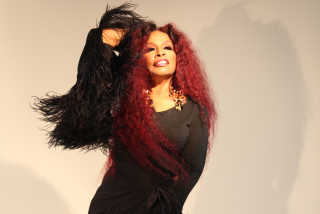Tim Robbins and the Actors’ Gang seek to ‘Break the Whip’
To begin with, there was a reading assignment. Tim Robbins, actor and founder of the Actors’ Gang, had long admired “A People’s History of the United States,” the 1980 revisionist history book by the late Howard Zinn that tells America’s story from the perspective of have-nots rather than big shots.
Robbins asked all 60 or so Actors’ Gang members to read its sections on Christopher Columbus, Jamestown and pre-revolutionary Boston; then they began to explore the dramatic possibilities in a series of workshops last summer that he hoped would point toward a play.
“I thought it would make a great theater piece. Not a lot of us are descended from the aristocracy, [so] these stories register more palpably than stories of the aristocracies,” Robbins said last week after one of the preview performances of the play that came out of that process, “Break the Whip.” The play opens Saturday.
The Academy Award-winning actor has been a playwright for 25 years now, and “Break the Whip” is the sixth full-length work he has written or co-written for the company he launched in 1981 while still a student in UCLA’s theater program. He’s also the show’s director, and with the actors whose improvisations gave rise to this historical play about the early years of Jamestown, Robbins throws every theatrical device at the audience but the kitchen sink.
In a way, they get that too: A “kitchen sink” play is a drama set in the bosom of the family and steeped in everyday realism. The family in whose bosom “Break the Whip” takes place is the American people, and although the production doesn’t include kitchen sink realism, it does strive for a strong degree of historical accuracy, or at least plausibility.
Jamestown was the first place where English-speaking whites, native Americans and African slaves were thrown together. “Break the Whip” deploys 23 actors, speaking three languages — a modified Elizabethan English, Algonquin and Kimbundu, the tongue of the Angolan slaves who arrive in chains near the end of the first act. A fiddler, banjoist and drummer are stationed behind and high above the stage, higher even than the screen where supertitles translate the scenes spoken by slaves and Paspahegh Indians.
The acting style derives largely from 16th century Italy: the commedia dell’arte that the Actors’ Gang has fed on from its early days. All characters are masked, and key figures are drawn from the commedia’s palette of archetypes. The stew includes politics, class warfare, racism and, given the repeating motif of cannibalism among some of the starving colonists, human flesh. There is a klutzy hero, a talking bear and a hopeful, sacramental ending. There is romantic love — within and between races, and within and between sexes. There is shadow puppetry enacting the creation myths of Christians, Angolans and Native Americans, and the play as a whole can be viewed as a creation myth of sorts for an American nation.
A crucial moment in early, unscripted experiments came when one of the actors, Alicia Simmons, spontaneously erupted in a kind of nonverbal speaking-in-tongues, her imperiled slave-woman voicing not only anguish and fear, but a passionate claim on freedom and acceptance.
“When it happened it was disturbing but incredibly inspiring,” said Robbins. Not only did that moment make it clear that the Jamestown story was the chapter in their reading assignment that ignited the keenest emotions in the actors, but “I knew the ending of the play when we saw it.”
By January, Robbins had written a script. Rehearsals showed him that what he’d written was going to need translating — not in the directorial sense of describing and analyzing the text, but in the linguistic sense. The credits include translators Carolyn Viera-Martinez (Kimbundu) and Bruce Pearson (Algonquin).
“We saw the native scenes acted in English and it didn’t feel right,” Robbins said. “In order to honor these peoples’ lives, we felt we needed to speak their language.”
With that decision, the actors’ task doubled or tripled. “I’ve told Tim, ‘This is the most difficult thing I’ve ever done on stage.’ I sort of shudder to think of the actual number of hours I spent working on all of the words,” said Scott Harris, who speaks virtually all of his many lines in Algonquin.
Robbins’ previous plays typically have been sorties in the culture wars, conceived to fire satirical ammo from the left. In examining Jamestown’s more distant history, Robbins said, the aim was not to dramatize an actual episode, but to tell a story that takes imaginative leaps while maintaining a safety net of historical plausibility.
“Part of our job,” he said, “was to imagine and to dream and, with all respect, give life to a story that we knew had to have happened.”
Some plot points that may seem surprising are grounded in the historical record, said its history consultant, Kwinn Doran. Those include English aristocrats refusing to condescend to manual labor, even in the face of starvation, and Angolan slaves helping to save the colony with the sophisticated agricultural know-how they brought from their homeland.
Robbins says that the aim in telling a story of divisiveness and suspicion set from 1609 to 1621 is not to allegorize the mistrust in today’s America.
But for leading actor Harris, the play’s “many parallels” to the current national scene hit home.
“The hope that we’re looking toward at the end is really what society needs in general,” Harris said. “If most people saw this and saw the generosity of spirit, it would be a good listen for everybody.”
mike.boehm@latimes.com
More to Read
The biggest entertainment stories
Get our big stories about Hollywood, film, television, music, arts, culture and more right in your inbox as soon as they publish.
You may occasionally receive promotional content from the Los Angeles Times.







